Why you can trust Tom's Hardware
Comparison Products
We tosssed the WD Black into the ring with the newest Gen4 SSDs out including Samsung’s 980 Pro and Sabrent’s Rocket NVMe 4.0 as well as a bunch of the best Gen3 SSDs going. These include the Intel Optane SSD 905P, Adata XPG SX8200 Pro 2TB, Samsung 970 EVO Plus, Crucial P5 2TB, WD Black SN750 2TB, Sabrent Rocket NVMe 4.0 2TB, Sabrent Rocket Q 2TB, and a SATA-based Seagate FireCuda 120 for good measure.
Game Scene Loading - Final Fantasy XIV
Final Fantasy XIV Stormbringer is a free real-world game benchmark that easily and accurately compares game load times without the inaccuracy of using a stopwatch.
When it comes to game load performance, there isn’t a whole lot of difference between the fastest and slowest SSDs for the average user. The AN1500 is up there with the best, but it is not quite as fast as the Samsung 980 PRO or Intel Optane SSD 905P on this particular benchmark. It is notably faster than the Phison E16 powered Sabrent Rocket NVMe 4.0, however.
Transfer Rates – DiskBench
We use the DiskBench storage benchmarking tool to test file transfer performance with our own custom blocks of data. Our 50GB data set includes 31,227 files of various types, like pictures, PDFs, and videos. Our 100GB includes 22,579 files with 50GB of them being large movies. We copy the data sets to new folders and then follow-up with a reading test of a newly written 6.5GB zip file and 15GB movie file.
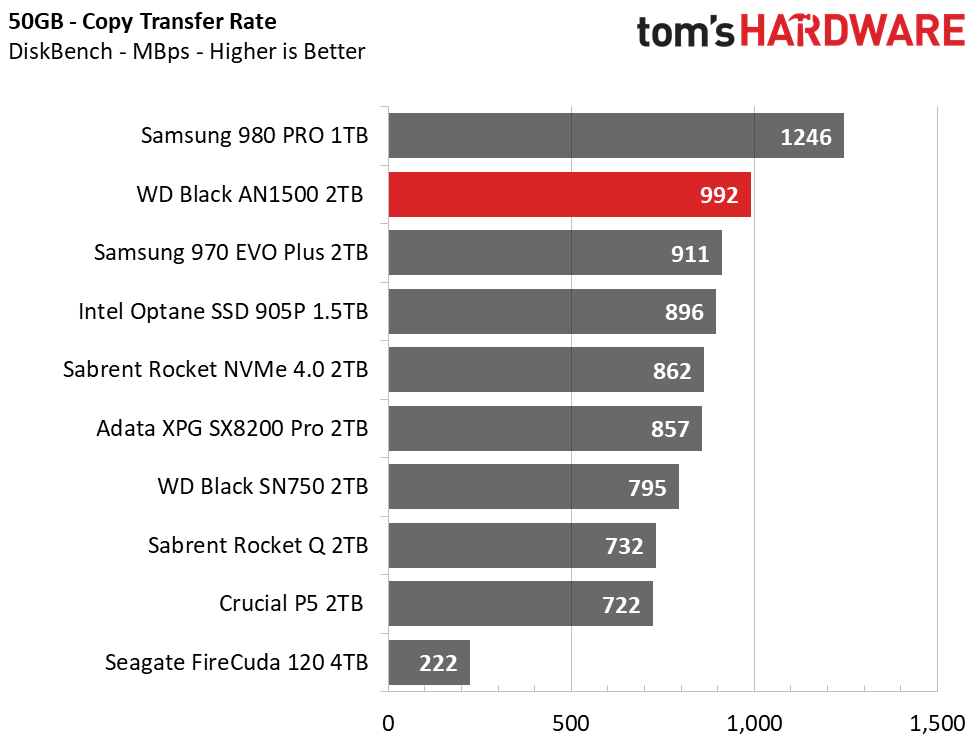
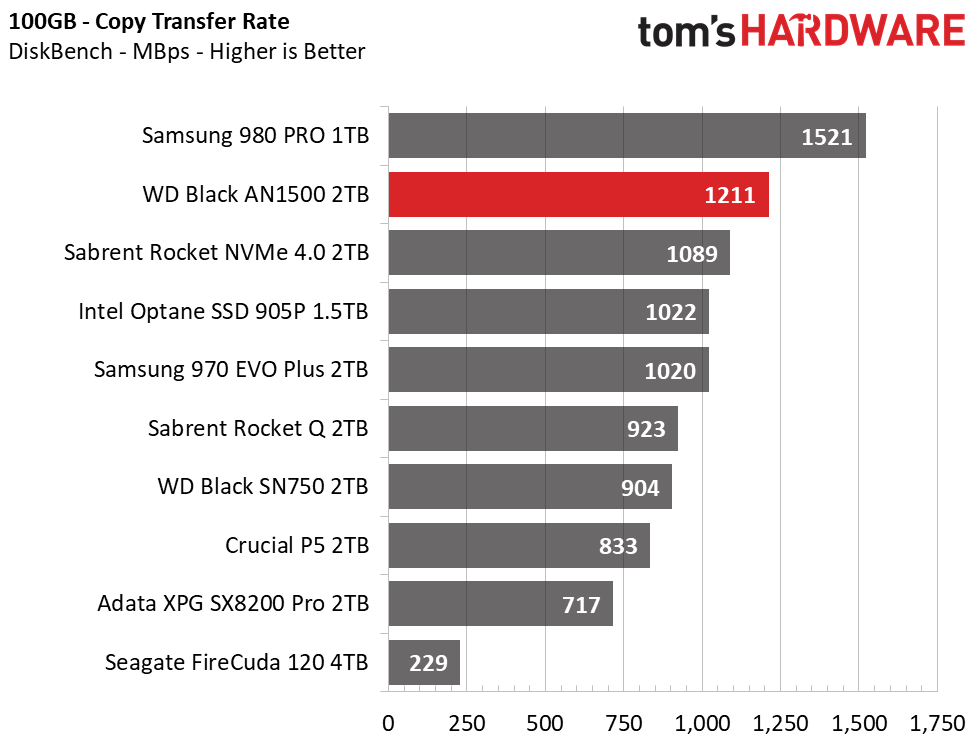


When transferring around large datasets, WD’s Black AN1500 offers a lot of performance but lags the Samsung 980 PRO. With its static SLC cache and very fast direct-to-TLC write speed, the AN1500 delivers much more consistent results than the 980 PRO when hitting the device with multiple rounds of transfers. When reading back the data, it is just slightly behind the 980 Pro but offers a significant improvement over the Gen3 competition.
Trace Testing – PCMark 10 Storage Tests
PCMark 10 is a trace-based benchmark that uses a wide-ranging set of real-world traces from popular applications and common tasks to measure the performance of storage devices. The quick benchmark is more relatable to those who use their PCs for leisure or basic office work, while the full benchmark relates more to power users.

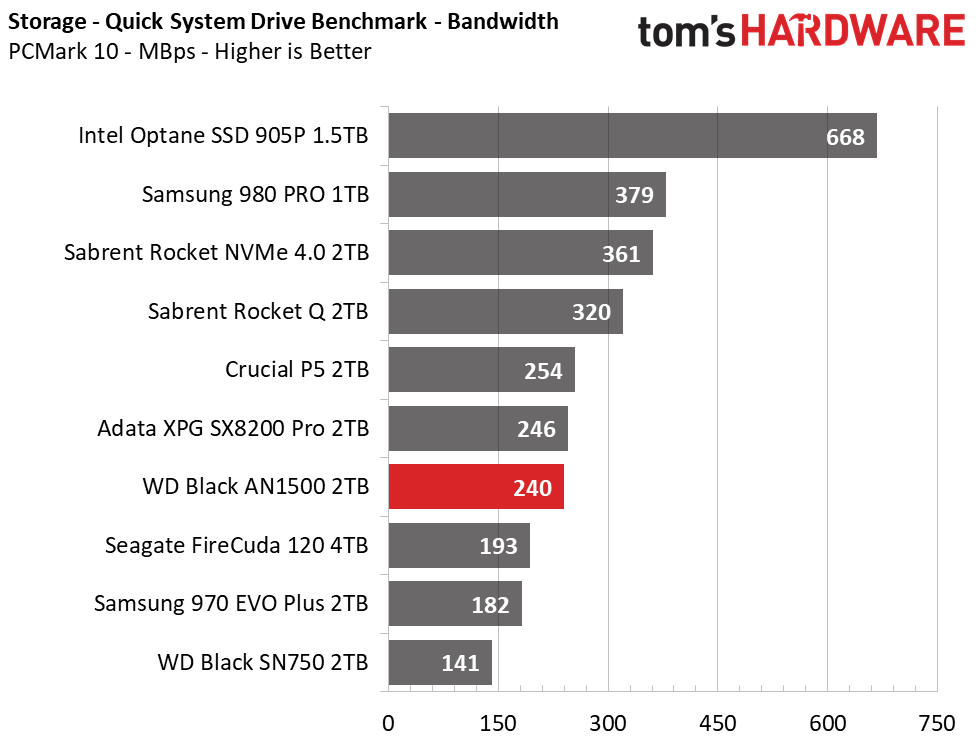




For most ordinary, simple tasks such as interface with the UI and launching your favorite game or application, the WD Black AN1500 will respond quickly, but it isn’t the most responsive design for consumers. To fully appreciate the AN1500, you'd have to perform large file transfers often or reading large datasets. Still, when hit with the Full System Drive benchmark, WD’s Black AN1500 ranked behind most of the Gen4 SSDs as well as Intel’s Optane 905P.
Get Tom's Hardware's best news and in-depth reviews, straight to your inbox.
Trace Testing – SPECworkstation 3
Like PCMark 10, SPECworkstation 3 is a trace-based benchmark, but it's designed to push the system harder by measuring workstation performance in professional applications.


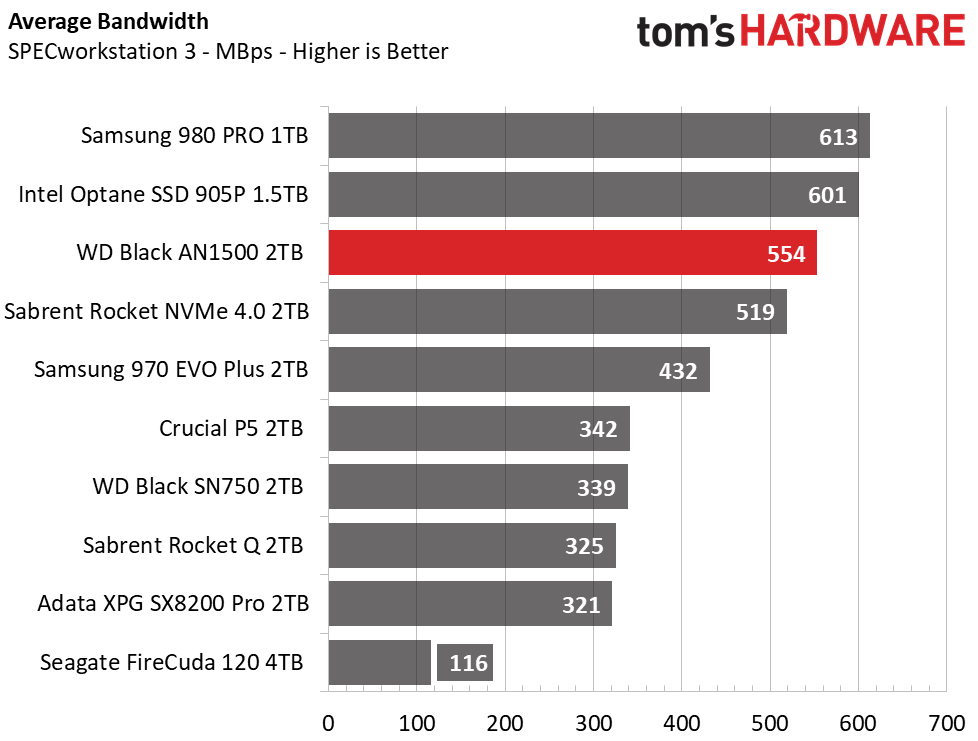

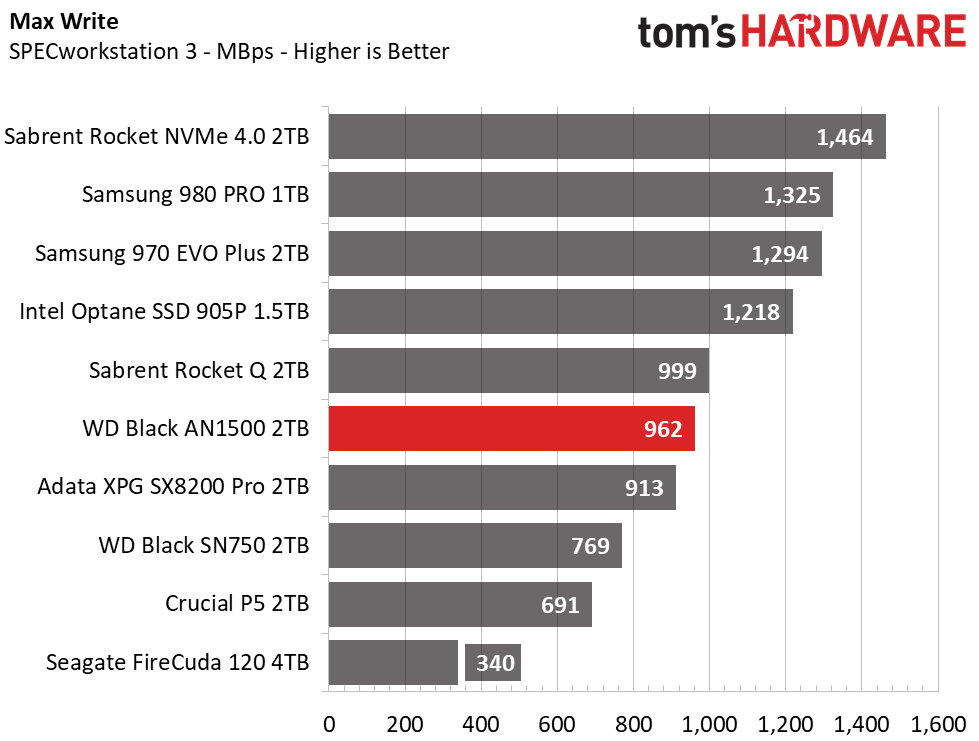
Sporting Optane memory, Intel’s Optane SSD 905P again offers some of the most responsive speeds for a Gen3 SSD yet. But unable to fully saturate its link, it loses some ground to both the WD Black AN1500 and Samsung 980 PRO in some workloads. WD’s Black AN1500 scores well and delivers some very high read throughput. But unlike Intel’s Optane SSD 905P or Samsung’s 980 PRO, it isn’t a chart-topper.
Synthetic Testing - ATTO / iometer
iometer is an advanced and highly configurable storage benchmarking tool while ATTO is a simple and free application that SSD vendors commonly use to assign sequential performance specifications to their products. Both of these tools give us insight into how the device handles different file sizes.
In ATTO, we tested WD’s Black AN1500 at a QD of 1, representing most day-to-day file access at various block sizes. Performance scales up slower than the Gen4 competitors, and at smaller file sizes it lags the performance of its Gen3 competition. It was able to achieve over 6.5/5.2 GBps, however, when using a test block size of 1MB, an increase from the 128KB block size normally tested with. Also, at low queue depths (QDs), its random responsiveness is similar to Samsung’s 970 EVO Plus, but when the QDs stack, it can sustain much higher levels of performance.










Sustained Write Performance and Cache Recovery
Official write specifications are only part of the performance picture. Most SSDs implement a write cache, which is a fast area of (usually) pseudo-SLC programmed flash that absorbs incoming data. Sustained write speeds can suffer tremendously once the workload spills outside of the cache and into the "native" TLC or QLC flash. We use iometer to hammer the SSD with sequential writes for 15 minutes to measure both the size of the write cache and performance after the cache is saturated. We also monitor cache recovery via multiple idle rounds.

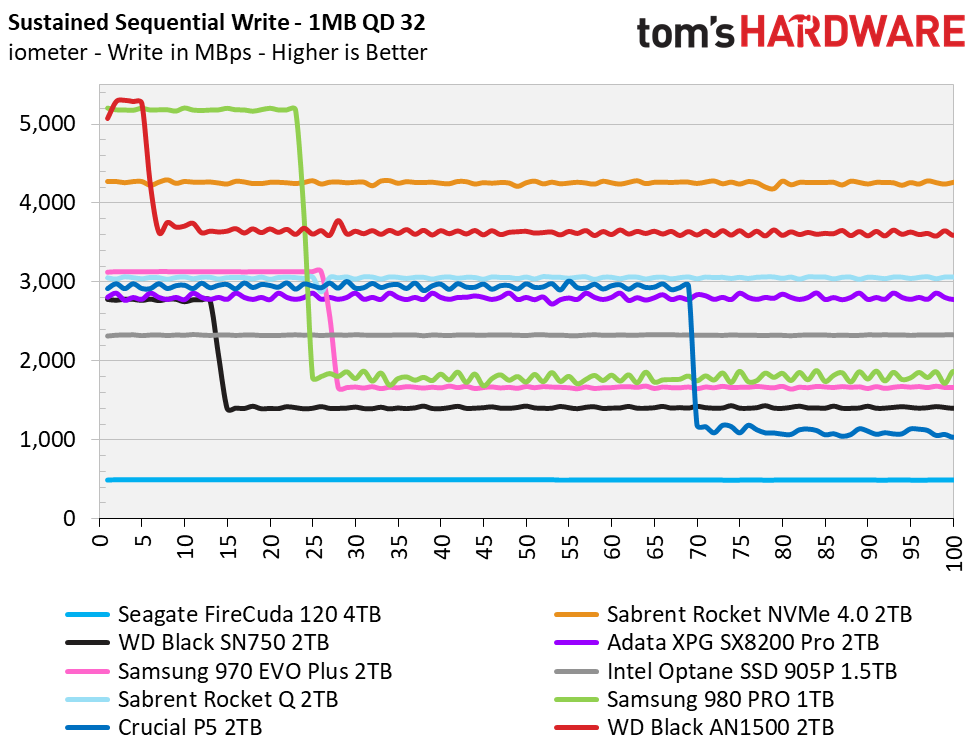



The WD Black AN1500’s write cache is small in size when compared to the large dynamic caches many SSDs come with. However, with a smaller static SLC cache, the WD SN730s offer the AN1500 some incredible sustained write speed that is fairly quick to recover. After writing 30-32GB, the AN1500’s write performance degraded from roughly 5.3 GBps down to 3.6 GBps until full. And after the transfer completes, the SSD just needs a few seconds to recover.
Power Consumption and Temperature
We use the Quarch HD Programmable Power Module to gain a deeper understanding of power characteristics. Idle power consumption is an important aspect to consider, though less so here than for drives that are likely to land in laptops. Some SSDs can consume watts of power at idle while better-suited ones sip just milliwatts. Average workload power consumption and max consumption are two other aspects of power consumption, but performance-per-watt is more important. A drive might consume more power during any given workload, but accomplishing a task faster allows the drive to drop into an idle state faster, which ultimately saves power.
We also monitor the temperature of the drive via the S.M.A.R.T. data and an IR thermometer to see when (or if) thermal throttling kicks in and how it impacts performance. Bear in mind that results will vary based on the workload and ambient air temperature.





Consuming upwards of 16 watts under peak load, the WD Black AN1500 is a far throw away from being called an efficient SSD. Even at idle, the AN1500 consumes a substantial 6 watts. When copying our 50GB file folder, the WD Black AN1500 consumed triple the power of its competitors, rivaling even Intel’s Optane SSD 905P’s glutinous power appetite.
Because of this, the SSD idles hot, with the surface measuring 51 degrees Celsius when in a 24-degree Celsius room with no airflow. Fortunately, with such a robust design, it doesn’t increase much at all beyond that, even after sustaining 1.2TB of writes. After the transfers, the peak surface temperature was roughly 55 degrees Celsius, with the PCB sensor reporting 67 degrees Celsius. Although well within operating limits, we would suggest at least some airflow over this drive, which shouldn't be difficult given it's an add-in card.
MORE: Best SSDs
MORE: How We Test HDDs And SSDs
MORE: All SSD Content

Sean is a Contributing Editor at Tom’s Hardware US, covering storage hardware.
-
nofanneeded We already have barebone NVME cards that can raid 4 NVME SSD , and used 16 lanes as well . I dont see This product can compete against that .. I am puzzled at WD choices ...Reply -
Grindayzier Reply
This will work good in my 6 core LGA 2011 rig :)nofanneeded said:We already have barebone NVME cards that can raid 4 NVME SSD , and used 16 lanes as well . I dont see This product can compete against that .. I am puzzled at WD choices ... -
gg83 I just want the empty shell. Ive wanted an rgb add in card for a while. i just want the lights. I could give a crap about 300 for 1tb! what a joke!Reply -
jesselafantaisie Wouldn't this force gpu to 3.0 8x therefore how could this be designed for gamers?Reply
